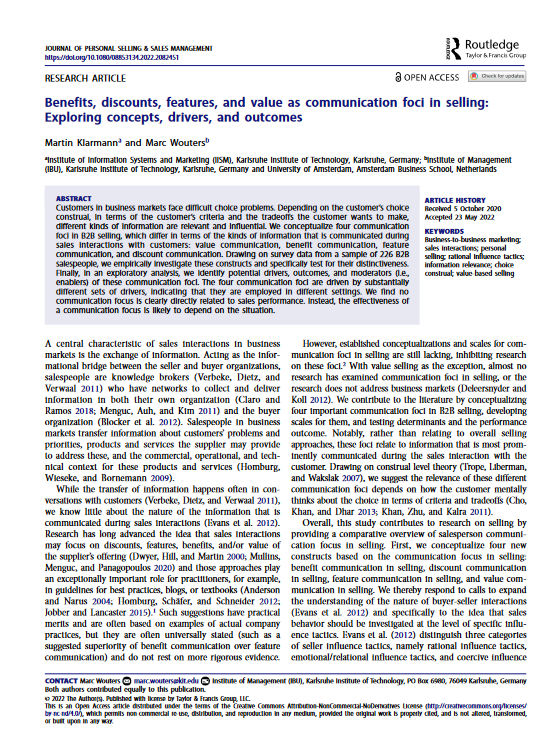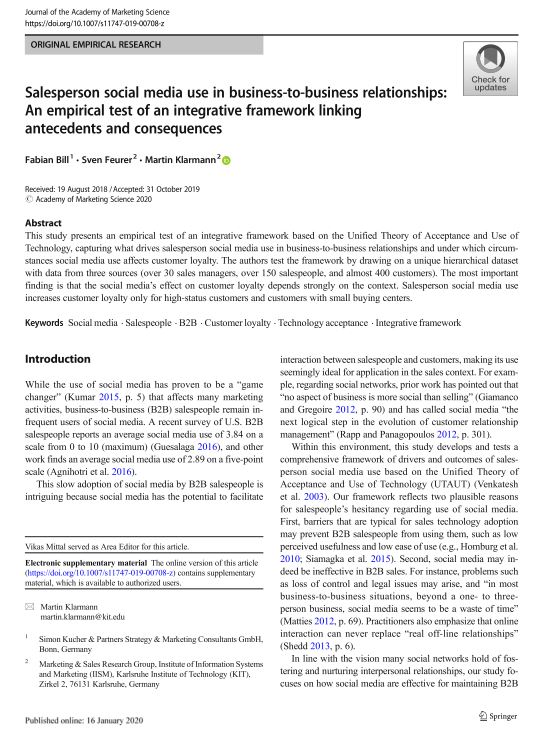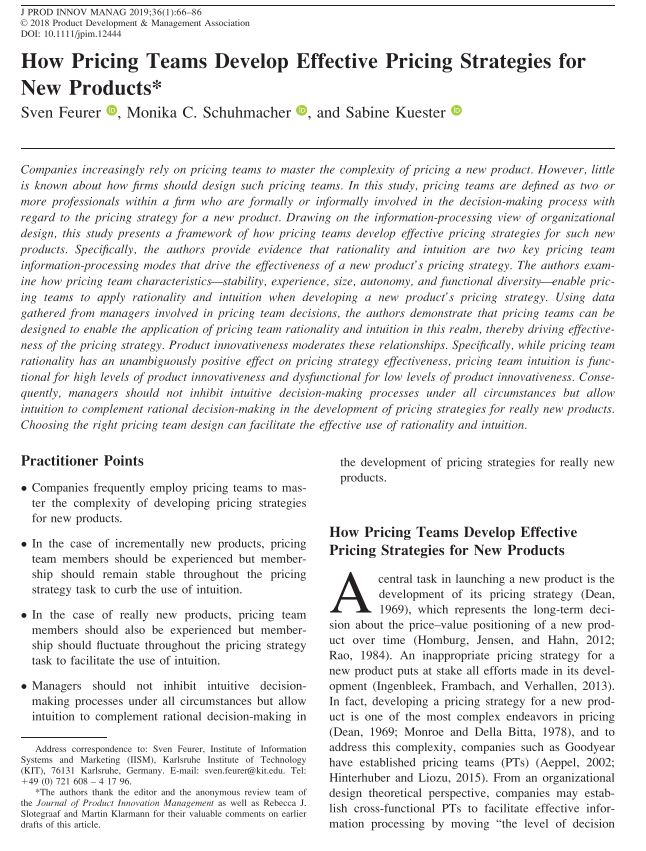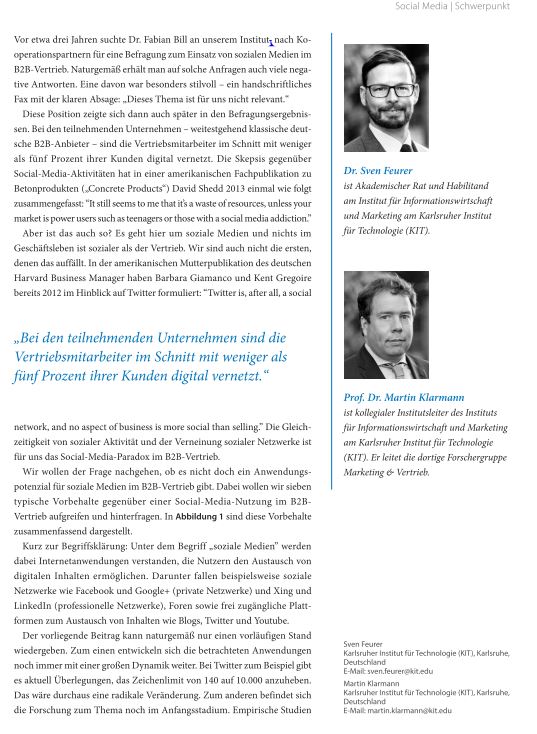Selected publications
↵
 |
 |
 |
 |
|
Benefits, Discounts, Features, and Value as Communication Foci in Selling: Exploring Concepts, Drivers, and Outcomes Klarmann, Martin and Marc Wouters Journal of Personal Selling and Sales Management (2022) |
Salesperson social media use in business-to-business relationships: An empirical test of an integrative framework linking antecedents and consequences Fabian Bill, Sven Feurer & Martin Klarmann Journal of the Academy of Marketing Science (2020) |
How pricing teams develop effective pricing strategies for new products Sven Feurer, Monika C. Schuhmacher & Sabine Kuester Journal of Product Innovation Management (2019) |
B2B-Vertrieb und das Social-Media-Paradox Sven Feurer & Martin Klarmann Sales Management Review (2016) |
Current Research Projects
B2B Sales
Buying Behavior in B2B and the role of Total Costs of Ownership in sustainable purchasing. Sustainable purchasing decisions are no longer just a trend—they have become a necessity for businesses looking for long-term success and as well for individuals trying to optimize their buying behavior. However, true sustainability in buying behavior goes beyond environmental considerations. Economic sustainability plays a crucial role, as products with the lowest purchase price often result in higher long-term costs. Despite the advantages of incorporating Total Cost of Ownership (TCO) into procurement strategies, many buyers continue to prioritize upfront costs over total lifecycle expenses. Why is this the case? How can decision-makers be encouraged to integrate TCO more effectively into their purchasing processes? What heuristics help in making economically and ecologically sustainable choices? And do tools like energy labels support or hinder TCO-based decision-making? To answer these questions, this research employs a multi-method approach, combining machine learning algorithms, Bayesian hierarchical modeling, and conjoint analysis. The goal is to uncover decision-making patterns, develop strategies to promote sustainable procurement, and design actionable insights for businesses. For further information, please contact: Alicia Gerlach.
Sales automation. Digital transformation in B2B firms has intensified the use of sales automation technologies in B2B sales teams leading to an increased efficiency and effectiveness. The goal of this research project is to investigate new digital technologies for sales automation such as artificial intelligence applications in B2B sales. What are the consequences of technology-mediated virtual interaction between the salesperson and the customer? What role will the salesperson as a human play in an increasingly digitalized and automated business environment? Will sales automation technologies eventually replace salespeople? For further information, please contact: Anne Cordts Value selling. It is a common recommendation that successful salespeople emphasize the economic value of their offering in customer conversations. In this research project, we analyze value selling empirically. How can value selling be measured empirically? What are prerequisites? Is value selling really linked to beneficial performance outcomes, even if other types of salesperson behavior are controlled for? Using a sample of more than 200 B2B salespeople we seek answers to these questions. For further information, please contact: Martin Klarmann or Marc Wouters
|
Marketing, Sales & AI
Understanding the threshold where hyper-personalization turns into over-personalization. Advancements in hyper-personalization allow companies to create highly customized consumer experiences by leveraging vast amounts of data. While this can enhance relevance and engagement, there is a fine line between useful personalization and intrusive over-personalization. When does hyper-personalization become too much, leading to discomfort, skepticism, or even consumer resistance? This research explores the emotional responses to over-personalization, identifies the threshold at which personalization becomes excessive, and examines the individual traits that influence where this boundary lies. For further information, please contact: Luisa Weber
Creative Automation Can a machine truly be creative? For centuries, creativity has been something intrinsic to humans - a quality that not only sets us apart from others, but also brings joy and meaning to our lives. However, with the evolution of AI tools such as ChatGPT and DALL-E, algorithms are constantly producing content that rivals human creativity. What happens when machines, rather than humans, become the architects of digital communication? The first research project is to understand how branded AIs can be used to provide consumers with transparency about whether or not they can trust a brand utilizing AI technologies such as OpenAI, Gemini, or Microsoft Coworker. For further information, please contact: Alessa Daumann
Personas (in new product development & marketing) serve as data visualization and communication tool to enhance customer understanding. Due to a lack of knowledge and resources, it often becomes a “fill-in-the-blank academic exercise” (Carson 2022) in practice. Indeed, if visual representations are driven by subjective mental models such as stereotypes, they can bias decisions and lead to negative outcomes such as new product ideas that are neither innovative nor customer oriented. An example for evolving design practices through artificial intelligence is the application of machine learning to make inferences about consumers based on online activities. This relates to the human capability of using partial knowledge to draw conclusions – the interpretative step that affects both Persona creation and perception. We investigate those two steps in the context of new product ideation and create an automatic Persons generation tool based on text mining techniques and natural language generation. For further information, please contact: Beatrice Weber
Deciphering the Adaptive Nature of Employee-Customer Conversations using Voice and Text Analytics. Customer-employee interactions are shaped by dynamic processes such as emotional contagion and mirroring, which influence trust, engagement, and decision-making. But how do these adaptive communication patterns unfold, and what impact do they have on interaction outcomes? This research leverages voice and text analytics to examine the mechanisms behind these dynamics, using large-scale call center data and controlled lab experiments. By addressing these questions, we contributes to a deeper understanding of how adaptive communication unfolds and its implications at the intersection of marketing and data-driven analytics. For further information, please contact: Saskia Jacob
Manipulation along the Online Customer Journey and the Role of Artificial Intelligence. The increased use of artificial intelligence (AI) in online marketing have enabled firms to practice marketing in an increasingly automated and individualized way. Consumers´ decision making processes along their online journeys are influenced by the use of new technologies in order to "nudge" consumers through so-called moments-of-truth, influencing future consumer behavior. Modified choice architectures, technology-mediated simulations of social interactions, data-driven targeting, or algorithmic communication in the form of programmatic advertising or recommender systems stimulate debates about the manipulative character of new marketing technologies. We investigate AI-mediated marketing practices along the online customer journey against the background of the fuzzy notion of manipulation. For further information, please contact: Robin Pade
The Effectiveness of Brands in Voice Shopping. Presently every fifth US household owns a smart speaker that comes with voice shopping functionality. Voice shopping is a new phenomenon characterized by sequential product presentation. Sequential product presentation can alter consumer’s decisions since it changes the way information is distributed among consumers (e.g. a consumer has up to no knowledge what the next option will be). This could affect brand effectiveness since a situation could arise at which many consumers simply choose one of the first presented products without assessing further products and independent from their brand. This research projects examines whether or not such a scenario is likable and how the effectiveness of brands changes in voice shopping. For further information, please contact: Martin Klarmann |

